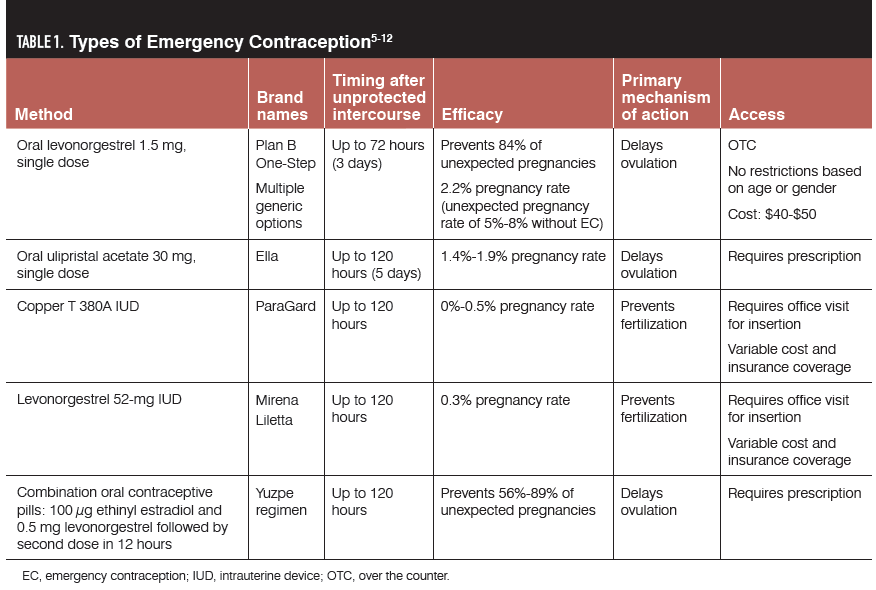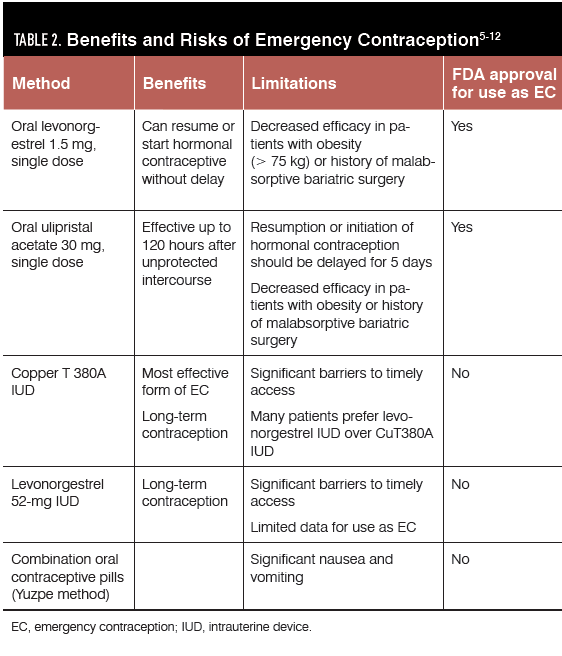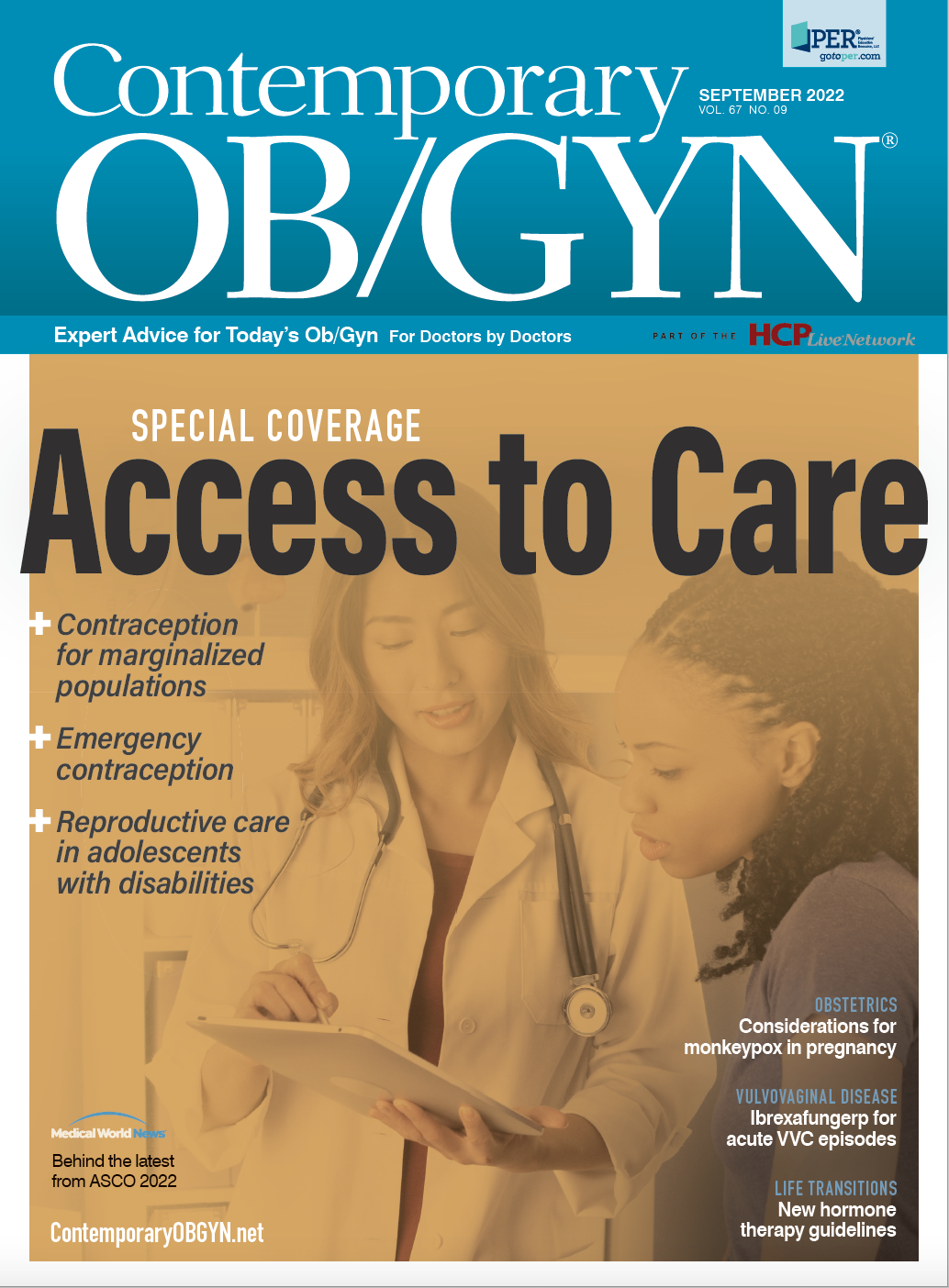Updates on emergency contraception
Nearly half (45%) of all pregnancies in the United States from 2015 to 2019 were unintended.
Nearly half (45%) of all pregnancies in the United States from 2015 to 2019 were unintended.1 The majority of such pregnancies occur in patients who are not using contraception or are inconsistently using contraception. Emergency contraception is treatment to prevent pregnancy after unprotected vaginal intercourse or when there has been a contraceptive failure, and has an important role in reducing unintended pregnancy.2 Unfortunately, patients are likely to receive inaccurate information about emergency contraceptive pills from retail pharmacies.3 Additionally, significant gaps exist in training and knowledge of emergency contraception among obstetrics-gynecology and family medicine residents.4 For these reasons, as well as the concerns stemming from anticipated changes in the legal options for reproductive health care across the United States, clinicians must remain vigilant about their knowledge being up-to-date to dispel misinformation and help patients make informed decisions (Table 1 and Table 2).5-12
TABLE 1. Types of Emergency Contraception5-12

TABLE 2. Benefi ts and Risks of Emergency Contraception5-12

FDA-approved emergency contraception
Two FDA-approved emergency contraceptive pills (ECPs) are available in the United States: oral levonorgestrel 1.5 mg as a single dose (Plan B One-Step or generic equivalents) and oral ulipristal acetate 30 mg as a single dose (Ella).5,6 The 2-dose levonorgestrel regimen is no longer manufactured. ECPs are not indicated in the setting of known pregnancy, but do not harm or disrupt an existing pregnancy if inadvertently taken. A urine pregnancy test is not required prior to administration of ECPs and there are no absolute contraindications. Specifically, ECPs are acceptable in patients with medical comorbidities such as cardiovascular disease, a history of venous thromboembolism, or a history of ectopic pregnancy. Women who are lactating may also safely take oral levonorgestrel. ECPs may be less effective in patients with obesity (> 75 kg) or a history of malabsorptive bariatric surgery, but there are no safety concerns regarding these populations.7,8 Both ulipristal and levonorgestrel can cause nausea; if vomiting occurs within 3 hours of taking an ECP, another dose should be administered.7
Single-dose oral levonorgestrel may be taken within 72 hours
(3 days) of unprotected intercourse or contraceptive failure. It is available over the counter to individuals of any age or gender without a prescription or an ID being required.9 The primary mechanism of action is prevention of ovulation. The drug may also alter the endometrium to inhibit implantation but isnot effective once implantation has occurred. Single-dose levonorgestrel prevents up to 84% of expected pregnancies and is more effective the sooner it is taken after unprotected intercourse or contraceptive failure. It will not affect long-term fertility and patients may resume or start hormonal contraception without delay. Levonorgestrel is typically well tolerated, but adverse effects include menstrual changes, nausea, vomiting, lower abdominal pain, fatigue, headache, dizziness, and breast tenderness.5
Single-dose oral ulipristal acetate is available by prescription only and may be taken up to 120 hours (5 days) after unprotected intercourse or contraceptive failure. Ulipristal acetate is a progesterone agonist/antagonist that postpones ovulation. In clinical trials, the expected pregnancy rate of 5.6% without emergency contraception was reduced to 1.9% with ulipristal acetate.6 When compared with levonorgestrel, the pregnancy rate was lower with ulipristal acetate (1.4% vs 2.2%).10 After taking ulipristal acetate, patients should delay initiating or resuming hormonal contraception for at least 5 days because exogenous progesterone may reduce ulipristal acetate’s ability to delay ovulation. Patients should use barrier methods until their next menses.5 Lactating patients should be counseled to express and discard breastmilk for 24 hours after taking ulipristal acetate as its excretion in breastmilk is highest in the first 24 hours.7 As with levonorgestrel, common adverse effects of ulipristal acetate include headache, abdominal pain, nausea, dysmenorrhea, fatigue, and dizziness.6
Methods without FDA labeling for emergency contraception
The Paragard intrauterine copper contraceptive (CuT380A) and high-dose combination estrogen and progesterone regimen (Yuzpe method) have been used for many years for emergency contraception.7 More recently, there is evidence that the 52-mg levonorgestrel-releasing intrauterine system (Mirena) is effective for emergency contraception as well.11 Neither method has FDA labeling for emergency contraception.
The Yuzpe method comprises a dose of 100 µg of ethinyl estradiol and
0.5 mg of levonorgestrel taken together, followed by a second dose of both hormones in 12 hours. This regimen is not sold as an emergency contraceptive product but consists of a variety of typical combination hormonal contraceptive pills. Patients using the Yuzpe method are significantly more likely to have nausea and vomiting than those taking single-dose ECPs. This regimen prevents 56% to 89% of unexpected pregnancies.10
The CuT380A intrauterine device (IUD) has been used for emergency contraception for over 20 years. It can be inserted up to 120 hours after unprotected intercourse or, if the timing of ovulation is known, more than 5 days after unprotected intercourse if insertion occurs no later than 5 days after ovulation.7 Its primary mechanism is preventing fertilization by impairing sperm viability and function and it may also prevent implantation if fertilization has already occurred. It is the most effective form of emergency contraception, with pregnancy rates of 0% to 0.5%.10 Prior to inserting CuT380A, the health care provider must be reasonably certain that the patient is not already pregnant. Other contraindications to insertion are acute pelvic inflammatory disease, uterine abnormality resulting in distortion of the uterine cavity, endometritis in the past 3 months, and known uterine or cervical malignancy. A significant benefit of this IUD is that it can remain in place for 10 years as a long-term contraceptive method.12 However, use of the device for emergency contraception is limited by patients having to undertake an office visit for insertion within 5 days of unprotected intercourse, as well as by cost and insurance coverage; additionally, patients frequently prefer the levonorgestrel IUD over the copper IUD.11
The levonorgestrel IUD is the most common IUD selected for long-acting contraception in the United States. A recent noninferiority trial randomly assigned patients to the levonorgestrel 52-mg IUD or CuT380A for emergency contraception within 120 hours of unprotected intercourse. The levonorgestrel IUD was noninferior to the CuT380A , with pregnancy rates of 0.3% and 0%, respectively. Similarly, retrospective data suggest the levonorgestrel IUD functions as emergency contraception.11 To date, the American College of Obstetricians and Gynecologists, Society of Family Planning, and the Centers for Disease Control and Prevention have not made recommendations regarding the use of the levonorgestrel 52-mg IUD for emergency contraception; in contrast, Planned Parenthood’s patient education materials include it as an option.13 It is unclear whether use of the levonorgestrel IUD for emergency contraception will become
widely accepted.
Conclusion
Several options are available for patients who are at risk for unintended pregnancy due to unprotected intercourse or contraceptive failure. Emergency contraception is safe and has very few contraindications. It does not cause abortion and does not reduce future fertility. Discussing emergency contraception should be part of all well woman preventive health care encounters, but particularly with patients who are at risk for unintended pregnancy including those who are not using contraception, those using a less reliable form of contraception, or those who may lose access to their contraception options. Although the copper IUD remains the most effective option for emergency contraception and can be inserted up to 5 days after unprotected intercourse, single-dose oral levonorgestrel 1.5 mg is safe, has no contraindications, and is available for patients to purchase without any restrictions due to age, gender, or insurance status.
References
1. Unintended pregnancy and abortion in Northern America. Guttmacher Institute. March 2022. Accessed August 9, 2022. www.guttmacher.org/fact-sheet/unintended-pregnancy-and-abortion-northern-america
2. Haeger KO, Lamme J, Cleland K. State of emergency contraception in the US, 2018. Contracept Reprod Med. 2018;3:20. doi:10.1186/s40834-018-0067-8
3. Ritter AH, Isaacs CR, Lee SM, Lee AJ. Single-dose levonorgestrel emergency contraception and silent barriers to its access: is it really just one step? J Womens Health (Larchmt). 2018;27(5):646-650. doi:10.1089/jwh.2017.6345
4. Rapkin RB, Griner SB, Godcharles CL, et al. Obstetrics and gynecology and family medicine residents’ training and knowledge on emergency contraception. J Womens Health (Larchmt). 2019;28(6):794-801. doi:10.1089/jwh.2018.7297
5. Plan B One-Step. Prescribing information. Duramed Pharmaceuticals, Inc; 2009. Accessed May 20, 2022. www.accessdata.fda.gov/drugsatfda_docs/label/2009/021998lbl.pdf
6. Ella. Prescribing information. HRA Pharma America Inc; 2021. Accessed May 20, 2022. https://www.accessdata.fda.gov/drugsatfda_docs/label/2021/022474s011lbl.pdf
7. Curtis KM, Tepper NK, Jatlaoui TC, et al. US medical eligibility criteria for contraceptive use, 2016. MMWR Recomm Rep. 2016;65(3):1-103. doi:10.15585/mmwr.rr6503a1
8. Kapp N, Abitbol JL, Mathé H, et al. Effect of body weight and BMI on the efficacy of levonorgestrel emergency contraception. Contraception. 2015;91(2):97-104. doi:10.1016/j.contraception.2014.11.001
9. Plan B One-Step. Fact sheet. PlanBOneStep.com. Accessed June 1, 2022. https://www.planbonestep.com/assets/downloads/plan-b-one-step-fact-sheet.pdf
10. Practice Bulletin No. 152: emergency contraception. Obstet Gynecol.2015;126(3):e1-e11. doi:10.1097/AOG.0000000000001047
11. Turok DK, Gero A, Simmons RG, et al. Levonorgestrel vs copper intrauterine devices for emergency contraception. N Engl J Med. 2021;384(4):335-344. doi:10.1056/NEJMoa2022141
12. Paragard. Prescribing information. CooperSurgical, Inc; 2019. Accessed May 20, 2022. www.accessdata.fda.gov/drugsatfda_docs/label/2019/018680s069s070lbl.pdf
13. How do IUDs work as emergency contraception? Planned Parenthood. Accessed May 20, 2022. www.plannedparenthood.org/learn/morning-after-pill-emergency-contraception/how-do-iuds-work-emergency-contraception

Recap on reproductive rights with David Hackney, MD, MS
December 20th 2022In this episode of Pap Talk, we spoke with David Hackney, MD, MS, maternal-fetal medicine physician at Case Western Reserve University and chair of ACOG's Ohio chapter for a full recap of where restrictions on reproductive rights have been and where they're going.
Listen
In this episode of Pap Talk, Gloria Bachmann, MD, MSc, breaks down what it means to be a health care provider for incarcerated individuals, and explores the specific challenges women and their providers face during and after incarceration. Joined by sexual health expert Michael Krychman, MD, Bachmann also discusses trauma-informed care and how providers can get informed.
Listen
No link found between hormonal contraception and clitoral adhesion severity
February 28th 2025A recent study presented at the ISSWSH 2025 Annual Meeting found no significant association between hormonal contraceptive use and the severity of clitoral adhesions, though researchers emphasize the need for further investigation.
Read More
